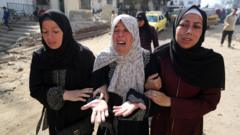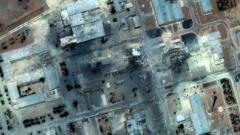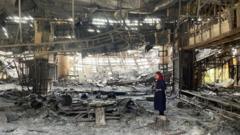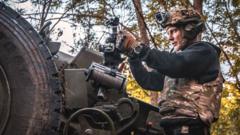In an alarming shift, Russia's latest wave of air assaults has brought unprecedented intensity to its military actions against Ukraine, impacting both urban and less frequently targeted regions.
Russia's Massive Drone and Missile Assault on Ukraine Escalates Conflict

Russia's Massive Drone and Missile Assault on Ukraine Escalates Conflict
An unprecedented scale of attacks targets Ukraine, striking areas previously deemed safe.
Russian forces launched a significant offensive overnight, deploying hundreds of drones and missiles across Ukraine, marking one of the most extensive assaults in the ongoing conflict. The Ukrainian military reported that around 537 aerial attacks were carried out, a record for a single night, with strikes reported in western parts of the nation, which typically remain untouched by such aggression.
This latest offensive represents a worrying trend of escalating air attacks by Russia, as they continually increase the volume of munitions used against Ukraine. With the introduction of nonlethal decoy drones designed to mislead Ukrainian air defenses, it has become increasingly challenging to assess the overall effectiveness of the offensive, as it significantly complicates comparisons with earlier stages of the conflict.
Ukrainian authorities stated that approximately 90 percent of the drones were intercepted, deactivated via electronic jamming, or failed to cause damage due to their decoy nature. However, the effectiveness against larger missile strikes was less impressive, with only two-thirds of the incoming missiles successfully neutralized, including a concerning one out of seven ballistic missiles.
The toll on human lives remains uncertain following these strikes. While there have been reports of damage and military casualties, particularly involving an airman in an F-16 aircraft, aspirations for a preservation of civilian safety during these aggressive military operations remain fragile and worrying. As fighting escalates, the reliance on fighter jets amid dwindling ground-based air defenses showcases the dire situation in which Ukraine finds itself.
This latest offensive represents a worrying trend of escalating air attacks by Russia, as they continually increase the volume of munitions used against Ukraine. With the introduction of nonlethal decoy drones designed to mislead Ukrainian air defenses, it has become increasingly challenging to assess the overall effectiveness of the offensive, as it significantly complicates comparisons with earlier stages of the conflict.
Ukrainian authorities stated that approximately 90 percent of the drones were intercepted, deactivated via electronic jamming, or failed to cause damage due to their decoy nature. However, the effectiveness against larger missile strikes was less impressive, with only two-thirds of the incoming missiles successfully neutralized, including a concerning one out of seven ballistic missiles.
The toll on human lives remains uncertain following these strikes. While there have been reports of damage and military casualties, particularly involving an airman in an F-16 aircraft, aspirations for a preservation of civilian safety during these aggressive military operations remain fragile and worrying. As fighting escalates, the reliance on fighter jets amid dwindling ground-based air defenses showcases the dire situation in which Ukraine finds itself.





















